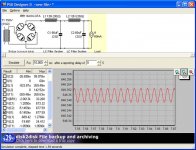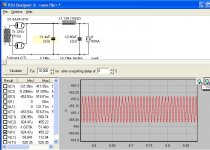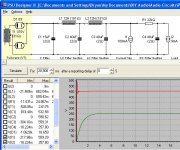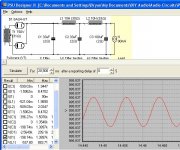Connectors:
There is a discussion here
Rectifier heaters:
I'm sure the hammond TX will be fine. Another alternative is to hand wind using HV wire on top of an existing toroid. About 3 turns per volt - don't forget to check "on load".
What happened to the damper diode idea? They have isolated heaters.
There is a discussion here
Rectifier heaters:
I'm sure the hammond TX will be fine. Another alternative is to hand wind using HV wire on top of an existing toroid. About 3 turns per volt - don't forget to check "on load".
What happened to the damper diode idea? They have isolated heaters.
Bryan,
I got 2 custom transformers made for my amp, by AE in the Netherlands. (
1 big transformer for all heaters: (correctly insulated)
gm70 needs 20V at 3A, the 866's, an 83, a 300b, a couple of 6.3V supplys, and a bias supply.
The other big transformer has the 2 hv windings.
This makes it easy to switch the hv on after everything is warmed up. You can find relais/switches easily for 220V, but try to find one for 1kV....
I also heard of several people who had good results with toroids to get the supply for the rectifiers. (I think aquablue used this in his 845 amp)
For connectors, I used one wich contains the heating and 300b supply. Connectors for about 400V are easy to find.
the ones I used
For the high voltage, I got a special high voltage bnc connector.
like
this (hope the link works)
rg58/59 work quite well for hv...
this
I got 2 custom transformers made for my amp, by AE in the Netherlands. (
1 big transformer for all heaters: (correctly insulated)
gm70 needs 20V at 3A, the 866's, an 83, a 300b, a couple of 6.3V supplys, and a bias supply.
The other big transformer has the 2 hv windings.
This makes it easy to switch the hv on after everything is warmed up. You can find relais/switches easily for 220V, but try to find one for 1kV....
I also heard of several people who had good results with toroids to get the supply for the rectifiers. (I think aquablue used this in his 845 amp)
For connectors, I used one wich contains the heating and 300b supply. Connectors for about 400V are easy to find.
the ones I used
For the high voltage, I got a special high voltage bnc connector.
like
this (hope the link works)
rg58/59 work quite well for hv...
this
dhaen,
The dampers are still a definate possibility. I think I may try both and see what my ears think... I have the 866As lying around and would like to use them in something, though this may not in fact be that project. I will also need the 2.5 volts for the heaters of the 2A3 or 45 should I go that route... I'm just trying to allow for options while I build. I am going to have a couple filament transformers wound, as they will be inexpensive, and properly rated.
I'm quickly thinking about scrapping the 45 as a driver option due to availability. If I can not source any good/cheap units I will focus my search solely on the 300B and 2A3. With the current production of 300Bs and many nos (though OUCH, $450 for a single WE NOS) lying around, this may be the way I go. 2A3 are currently produced as well, and "relatively" affordable all things considdered. We'll see what stocking stuffers I find on the 25th...
BTK
The dampers are still a definate possibility. I think I may try both and see what my ears think... I have the 866As lying around and would like to use them in something, though this may not in fact be that project. I will also need the 2.5 volts for the heaters of the 2A3 or 45 should I go that route... I'm just trying to allow for options while I build. I am going to have a couple filament transformers wound, as they will be inexpensive, and properly rated.
I'm quickly thinking about scrapping the 45 as a driver option due to availability. If I can not source any good/cheap units I will focus my search solely on the 300B and 2A3. With the current production of 300Bs and many nos (though OUCH, $450 for a single WE NOS) lying around, this may be the way I go. 2A3 are currently produced as well, and "relatively" affordable all things considdered. We'll see what stocking stuffers I find on the 25th...
BTK
The computer power supply idea will not work for the rectifiers since the 2.5 volts will be referenced to the B+.
I have used a Hammond 167Q5 to run 866's or 3B28's. It is a 5 volt center tapped 6 amp tranaformer. You put one tube across each half of the winding, and take the B+ from the CT.
The other possibility is to find a suitably sized toroid and add two extra windings through the core. You can leave the original windings intact, and even use them, as long as you don't exceed the original VA rating of the transformer. Obviously you need wire rated for at least 2KV.
When choosing the rectifier, I have found that 3B28's will drop into an 866 socket, with no radiated noise and hash. The sound is clearer also. If using 866's and noise is a problem, insert a 100 ohm 1 or 2 watt carbon comp resistor with 10 turns of wire wrapped around it (wired in parallel to it) in series with each plate lead. This lowers the nasties to an acceptable level. The 3B28's don't have the blue glow though.
The new production Chinese 300B's aren't bad tubes and can often be found for less than $50 each. I am using the Chinese 845's also. They are also quite good at less than $30 each. I can do things to these tubes that I would never try with an RCA. Even if you plan to use expensive tubes, get some of these for initial test out.
I have used a Hammond 167Q5 to run 866's or 3B28's. It is a 5 volt center tapped 6 amp tranaformer. You put one tube across each half of the winding, and take the B+ from the CT.
The other possibility is to find a suitably sized toroid and add two extra windings through the core. You can leave the original windings intact, and even use them, as long as you don't exceed the original VA rating of the transformer. Obviously you need wire rated for at least 2KV.
When choosing the rectifier, I have found that 3B28's will drop into an 866 socket, with no radiated noise and hash. The sound is clearer also. If using 866's and noise is a problem, insert a 100 ohm 1 or 2 watt carbon comp resistor with 10 turns of wire wrapped around it (wired in parallel to it) in series with each plate lead. This lowers the nasties to an acceptable level. The 3B28's don't have the blue glow though.
The new production Chinese 300B's aren't bad tubes and can often be found for less than $50 each. I am using the Chinese 845's also. They are also quite good at less than $30 each. I can do things to these tubes that I would never try with an RCA. Even if you plan to use expensive tubes, get some of these for initial test out.
45's, and globe type 245 are not all that rare, probably much less so than NOS WE 300B by several orders of magnitude. Check eBay from time to time, I have bought quite a few in the last few years for prices that I thought pretty decent, and all purchased were good.
One issue I am wrestling with as I am also embarking on a large dht amplifier that most probably will use 211's, but might also use 845's is that the available swing with a 1:1 IT is barely enough (arguably not enough) with the 45/2A3/300B as a driver, what the 2A3 and 300B have going for them is a much lower Rp which would comfortably permit the use of an IT with a 1:1.5 step ratio giving you more than enough voltage drive, either would also provide enough power for A2 operation if desired.
One other comment regarding filament supplies - if you do use the 866 rectifiers I would recommend an entirely separate filament transformer for them as they are quite noisy and some of this stuff may couple via interwinding capacitance and the mutual inductance between the windings. Also of course their filaments are sitting at >1KV and should there be an insulation failure it would be better if the fault current did not find ground through any of the circuitry powering the other filaments.
Kevin
One issue I am wrestling with as I am also embarking on a large dht amplifier that most probably will use 211's, but might also use 845's is that the available swing with a 1:1 IT is barely enough (arguably not enough) with the 45/2A3/300B as a driver, what the 2A3 and 300B have going for them is a much lower Rp which would comfortably permit the use of an IT with a 1:1.5 step ratio giving you more than enough voltage drive, either would also provide enough power for A2 operation if desired.
One other comment regarding filament supplies - if you do use the 866 rectifiers I would recommend an entirely separate filament transformer for them as they are quite noisy and some of this stuff may couple via interwinding capacitance and the mutual inductance between the windings. Also of course their filaments are sitting at >1KV and should there be an insulation failure it would be better if the fault current did not find ground through any of the circuitry powering the other filaments.

Kevin
If using 866's and noise is a problem, insert a 100 ohm 1 or 2 watt carbon comp resistor with 10 turns of wire wrapped around it (wired in parallel to it) in series with each plate lead. This lowers the nasties to an acceptable level.
Why bother? Solid state is more efficient and doesn't need an extra filament xfmr. You don't get that funkey blue glow, but still, I'd rather give that up since otherwise, MV rectifiers seem to be very much like silicon diodes.
After more deliberation, I will start off with with damper diodes, simply for the reason of a slow ramp to full B+. The mercury would be nice (and yes, I like the blue glow), but considering the downsides, I will probably just save them for another project down the road!
BK
BK
Bryan,
I'm going to be moving to central NJ towards the end of January. I've got 4 used Chinese KT88s you could use as drivers until something better comes along. Triode strap the screen grids to the plates with 470 Ohm resistors.
If only EI was turning out proper KT90s. A properly made EI KT90 is NICE when triode strapped.
A properly made EI KT90 is NICE when triode strapped.
I'm going to be moving to central NJ towards the end of January. I've got 4 used Chinese KT88s you could use as drivers until something better comes along. Triode strap the screen grids to the plates with 470 Ohm resistors.
If only EI was turning out proper KT90s.
Solid state is more efficient and doesn't need an extra filament xfmr.
Well, I think that would count for everything in a tube amplifier,
you're not making these things to enjoy efficiency.
If that's you're thing, you should go for a class-d amp.
My reason to use 866's and hv tubes is "because I can".
There are lots of ways to get good sound.
And at these voltages, solid state isn't as reliable as tubes.
you need to string diodes in series, and this isn't allowed/recommended with all diodes. be carefull.
Time to get serious....
The GF is away for the next five days, so I can get down to business. I will start breadboarding. I think it will be wise to breadboard each channel seperately, as this thing is going to weigh a ton! I will buy some wood this afternoon/tomorrow morning, with weight capacity in mind!
So, power supply. Lets start with the driver PS. I have available:
375VCT 300mA power transformer
12H 100mA chokes
multiple values of motor run caps (1, 2, 10, 20, 33, 50, 60, 100uF)
83 rectifier (and associated iron)
6au4 rectifiers (and associated iron)
silicon rectifiers
For this power supply, I will ultimatley like to run any and all of the driver options (45, 2A3, 300B, el34, KT 66, etc), so I want plate voltage which will be ample for every valve. I will be IT coupling this stage to the 845 grids. I'm thinking CLCLCRC tapping the driver off the third C and then the input off the final C. Choke input here will probably not give the voltage I need...
Given the available components, does anything jump out as obvious? Also, full wave, hybrid bridge, etc, keeping in mind useful working voltage for drivers....?
The GF is away for the next five days, so I can get down to business. I will start breadboarding. I think it will be wise to breadboard each channel seperately, as this thing is going to weigh a ton! I will buy some wood this afternoon/tomorrow morning, with weight capacity in mind!
So, power supply. Lets start with the driver PS. I have available:
375VCT 300mA power transformer
12H 100mA chokes
multiple values of motor run caps (1, 2, 10, 20, 33, 50, 60, 100uF)
83 rectifier (and associated iron)
6au4 rectifiers (and associated iron)
silicon rectifiers
For this power supply, I will ultimatley like to run any and all of the driver options (45, 2A3, 300B, el34, KT 66, etc), so I want plate voltage which will be ample for every valve. I will be IT coupling this stage to the 845 grids. I'm thinking CLCLCRC tapping the driver off the third C and then the input off the final C. Choke input here will probably not give the voltage I need...
Given the available components, does anything jump out as obvious? Also, full wave, hybrid bridge, etc, keeping in mind useful working voltage for drivers....?
So who's going to give you the "kiss of life"?The GF is away for the next five days, so I can get down to business. I will start breadboarding.
Seriously, playing with HV alone is hazardous. Take extra precautions.
Choke input is not really any advantage in this case as your driver stage should draw constant current.
Multiple element smoothing with chokes can give rise to strange turn-on / turn-off behaviour. Simulate it in PSUD2. Do you really need all that smoothing? My gut feeling is that 200mV of ripple is fine for the driver.
My suggestion: Only breadboard 1 channel until you are ready for serious listening tests. You can gauge a lot from 1 channel.
dhaen,
Ahh, the kiss of life... I didn't say I would turn anything on, just set it up! Cautions well noted!
It turns out I whould have plenty of HV, as the PS Tranny is 375-0-375. If I work up a full wave hybrid bridge, choke input, I'll have more volts than necessary.
Maybe something like this:
Ahh, the kiss of life... I didn't say I would turn anything on, just set it up! Cautions well noted!
It turns out I whould have plenty of HV, as the PS Tranny is 375-0-375. If I work up a full wave hybrid bridge, choke input, I'll have more volts than necessary.
Maybe something like this:
Attachments
Is there a general rule of thumb with respect to how much ripple is acceptable in the chain? And, at what point do we reach diminishing returns with respect to effort used clear these nasties?
I imagine that the ripple should be less for the input, compared to the driver, and less for the driver compared to the output tube. What ripple is acceptable for the driver tube?
Obviously if you can hear the effects at the speakers there is an issue, but how does this relate to real time numbers???
Thanks,
BK
I imagine that the ripple should be less for the input, compared to the driver, and less for the driver compared to the output tube. What ripple is acceptable for the driver tube?
Obviously if you can hear the effects at the speakers there is an issue, but how does this relate to real time numbers???
Thanks,
BK
OK,
Here is the driver PS with sim. I think the ripple will be low enough for both stages...
What I like about this supply is that I can tune the driver voltage by adjusting the first cap. Depending on values I can get from 450 with the cap input down to 250 for the choke input. This should allow me a lot of room to work with various drivers, no?
Here is the driver PS with sim. I think the ripple will be low enough for both stages...
What I like about this supply is that I can tune the driver voltage by adjusting the first cap. Depending on values I can get from 450 with the cap input down to 250 for the choke input. This should allow me a lot of room to work with various drivers, no?
Attachments
- Status
- This old topic is closed. If you want to reopen this topic, contact a moderator using the "Report Post" button.
- Home
- Amplifiers
- Tubes / Valves
- 845 A2 Monoblock Project



